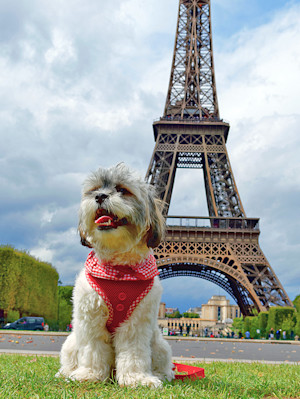
Share Article
Train travel is scenic, convenient, often quicker than driving and typically less stressful for dogs (and humans!) than flying.
In the UK, dogs are welcome on most trains. But what if you want to explore beyond the Channel? Can your pup hop on the Eurostar and trot off to Paris or Brussels with you?
Good news: it’s possible but like all good adventures, it comes with a few hurdles to jump.
How much do you spend on your pet per year?
Are dogs allowed on the Eurostar?
Yes, dogs are allowed on Eurostar, but with certain restrictions depending on the size of the dog and the route.
Eurostar pet policy overview
Unfortunately, you will have to catch a ferry or flight from the UK to Europe because pets are not allowed on trains to and from London. The same applies for trains between Brussels and Lille, or on the Eurostar Sunopens in new tab and Snow routesopens in new tab. However, you can travel with a guide or assistance dog or cat, but you’ll need to contact them at least 24 hours before your journey. You can find further information on travelling with guide dogs and assistance dogs hereopens in new tab.
Pets are welcome on all other routes between Belgium, France, Germany and the Netherlands.
General regulations
Dogs must be kept on a lead at all times in stations and on trains. Small dogs and cats can travel in a secure carrier no larger than 45x30x25 cm. The carrier must fit on your lap or at your feet. For larger dogs, you’ll need to purchase a pet ticket, and your dog must wear a muzzle throughout the journey. Always check with the specific train operator for the latest rules and requirements before booking.
Breed restrictions
Some train services may have restrictions on certain dog breeds deemed dangerous or aggressive, particularly larger guard breeds. These rules can vary by country and operator, so it’s essential to check in advance. Even if your dog’s breed is permitted, aggressive behaviour could still result in being refused travel. Muzzles are often required, regardless of breed, for larger dogs.
Documentation requirements
To travel between European countries, dogs must have a valid pet passportopens in new tab or Animal Health Certificate (AHC), depending on your country of origin. This documentation confirms your pet meets the health and identification requirements for cross-border travel.
You may have heard news that England, Scotland and Wales will be issuing pet passports againopens in new tab after (they were phased out post-Brexit) which will make it easier to travel to the EU with your pet. However, there is no confirmation yet on exactly what this change will entail or when it will be introduced.
Benefits of taking your dog on the Eurostar
Sure, you might need to start your trip with a ferry, but once you’re across the Channel, the Eurostar becomes one of the most comfortable and stress-free ways to travel with your dog.
You can travel side by side, without the worry of airport cargo or kennel stress.
Skip long ferry queues and hours behind the wheel. Train travel is quicker, calmer and far less hassle.
On approved routes, small dogs travel for free, and larger dogs pay a flat €30 (£26) fare. It’s transparent, affordable, and well worth it for the adventure ahead.
How to travel on the Eurostar with your dog
Before you go, make sure your dog is microchipped and vaccinated against rabies at least 21 days before travel. If you’re travelling from Great Britain to the EU, you’ll also need an Animal Health Certificate (AHC) issued by your vet within 10 days of departure. Tapeworm treatment is required when returning to the UK from some countries, like France.
Small dogs and cats under 6kg can travel free in a carrier (max 45×30×25 cm). Larger dogs need a €30 ticket and must be muzzled and on a lead. Assistance animals travel free but must be pre-booked at least 24–48 hours in advance.
Always double-check travel routes and carrier policies, and speak to your vet early to ensure all documentation is in order.
Just keep in mind: even if Eurostar allows pets on your chosen route, you’ll still need to follow UK government rules around documentation, vaccinations and approved travel routes if you're entering or returning to Britain.
Alternatives to Eurostar for pet travel
While Eurostar is a great option, there are plenty of other ways to travel with your dog:
Eurotunnel (Le Shuttle): Drive your own car or use a pet taxi like Le Pet Express. Pets stay with you. From ~£22–£185.
Ferries: Operators like P&O, DFDS and Stena Line offer kennels or pet-friendly cabins.
Pet taxis: Shuttles connect UK train stations with Eurotunnel terminals for seamless travel.
Plane: Not ideal for nervous petsopens in new tab, but an option for longer distances.
Drive: The most flexible choice. You can stop when neededopens in new tab and keep your pet close the whole way.
Tips for a smooth ride on the Eurostar with your dog
Practice travelling in a carrier or on a leash ahead of time.
Bring essentials: water, treats, food, waste bags, comfort item.
Be mindful of other passengers – Eurostar staff may relocate you if someone is uncomfortable.
Arrive at least 60 minutes early if travelling with an assistance dog.
Bottom line: taking your dog on the Eurostar
Despite being banned on many UK‑bound routes, Eurostar allows pets on select continental routes with clear rules. Small dogs can travel free in containers, larger dogs pay €30 and assistance animals travel free with pre‑booking. If London‑mainland travel is needed, alternatives like the Eurotunnel or ferries may be more practical.
Eurostar and dogs: frequently asked questions
Will Eurostar ever allow dogs?
There’s currently no indication of policy change: pets remain prohibited on UK‑bound and certain routes, with only guide/assistance animals allowed. The restrictions reflect operational and security constraints.
Can I take a dog through the Eurotunnel?
Yes! Eurotunnel accommodates pets within personal vehicles or via pet‑carrier shuttles. They require microchipping, rabies vaccination, a health certificate or passport and recent tapeworm treatment when entering the UK (24 hrs–5 days prior). Costs range from £22 (by car) to ~£185 (shuttles).
Can I bring my dog from London to Paris?
You cannot take your pet directly by Eurostar on London‑Paris or other London‑mainland routes. Instead, take a ferry or Eurotunnel option to cross to France, then continue via Eurostar from a mainland European station (eg Lille, Brussels).
Do dogs need a ticket to ride the Eurostar?
Small pets (< 6 kg) carried in an approved carrier travel for free.
Larger dogs need a €30 ticket bought onboard and must be leashed and muzzled.
Assistance dogs/cats travel free with a booking and proper documentation.

Nuala McHugh
Nuala is a writeropens in new tab with a background in PR. She has worked with brands including Jollyes, Universal Studios, and Amazon. Based in Northern Ireland, she is now doing what she loves most: writing with her clingy cockapoo Bobby by her side.
Related articles
![a little white dog in a red harness poses in front of the Eiffel tower]()
Excusez-Moi, Does My Dog Need a Passport to Go to France?
Planning on summering in France avec ton chien? Read this first
![]()
All Aboard! How To Take Your Dog On A Train Journey
Heading on a UK break? Here’s how to help your pup (and you) survive that stressful train journey
![Dog running on the beach]()
Can I Take My Anxious Dog On Holiday?
Think a holiday with your nervous pup is off-limits? You just need to make a few adjustments. Here’s how to have a dreamy trip that you and your anxious dog can enjoy
![a woman and her dog sit in a camper van door]()
5 Travel Lovers Who Take Their Pets on Every Adventure
Think a life on the road means leaving your pet behind? These pet parents disagree...
![]()
Does My Dog Need a Passport to Come to Ireland With Me?
Strap in, things are about to get complicated. Thanks Brexit





